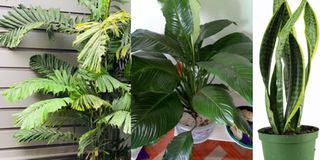Plants that naturally remove humidity

What you need to know:
According to NASA, the spider plant can remove up to 90 percent of the toxins in a room. Its leaves absorb moulds, dust, carbon monoxide and formaldehyde.
The rains have been here for quite some time and there is lots of humidity especially on the days when there is no sun. This, combined with leaky foundations, walls and roofs or windows and water pipes can cause the growth of moulds in the house.
Exposure to damp and mouldy environments may cause a variety of health effects such as a stuffy nose, wheezing and sometimes mould poisoning. Some people who have allergies to molds or with asthma may have intense reactions such as shortness of breath and fever according to the Centre for Disease Control.
Did you know that the accumulation of humidity in our home can be combated by plants that absorb moisture? Ethel Nambowa, a landscaper at Green Gardens remarks that these houseplants also add coziness to your room.
“It is also important that you factor out picking the type of plants that are particularly good for certain rooms in your house and need little to no attention. The homeowner must know the light and water requirements for these plants. For example, not all these plants thrive best in a bathroom, but it is the room in the home that has the most humidity,” she says.
Palms
Palms are a great choice in controlling humidity and keeping the moulds away because they absorb moisture through their leaves. There are several palm varieties to choose from, but areca palms, bamboo palms, lady palm, dwarf date palm and reed palm are the best for condensation.
Nambowa says, “Bamboo palms do not only absorb surrounding humidity but also purify the air. When planted in the outdoor environment, it can grow up to three metres height but its growth to full height is limited indoors. It grows well in a humid, shady location.”
Peace Lily
Their flowers are white which is a symbol of peace, hence the name. This moisture absorber loves shades and thrives well in humid places which makes it a perfect choice for mould prone areas like the bathroom.
The plant is good at absorbing moisture through its leaves then the moisture moves down the roots. It doesn’t need direct sunlight to thrive and can grow under minimal lighting.
The peace lily is also a perfect choice for people with asthma and allergies since it also purifies air but it is toxic to both humans and pets once ingested. Therefore, keep away from children and pets.
She says, “They are also great for those that suffer from allergies or asthma, and the plant produces beautiful flowers but is also toxic to pets so keep it out of reach. Remember to dust or wipe the leaves regularly to ensure they photosynthesize well. If the leaves turn brown it is a sign that the plant needs more watering, a more protected location away from the sun or a supply of manure.”
Spider plants
According to NASA, the spider plant can remove up to 90 percent of the toxins in a room. Its leaves absorb moulds, dust, carbon monoxide and formaldehyde. Also known as ribbon plants, the spider plant has long narrow leaves with yellow or white streaks.
Nambowa says, “It is a fast growing yet compact indoor plant that thrives with very minimal care. The spider plant neither requires much watering, lighting, nor does it have demanding care. The plant is also non-toxic and therefore have no worries if you have little ones.”
Mint
We should appreciate that mint is very handy in the kitchen as a cooking ingredient, but it can also absorb humidity from the environment. The plant is excellent at absorbing moisture from soil as well as the environment, therefore another natural way to get rid of moulds from your house.
Besides its fragrance which is energy boosting, mint can also be your go to plant for herbal tea. You can have it potted for your kitchen, bathroom or living room. It is very easy to grow indoors as long as there is enough moisture and lighting.
There are other ways of removing moulds such as using hydrogen peroxide, baking soda, tea tree oil and vinegar.
Snake plants
The snake plant is also known as mother-in-law’s tongue. It is a hardy and adaptable plant, and one of the best for absorbing condensation and moulds. It comes in several varieties with leaf shapes and colours similar to a snakeskin.
“It is also a good air purifier that absorbs household toxins and grows best in bright light and warm temperatures. It does not require daily maintenance. Minimum watering for a snake plant is once every week or two, making it a great starting plant for beginners that want an indoor plant,” she says.



